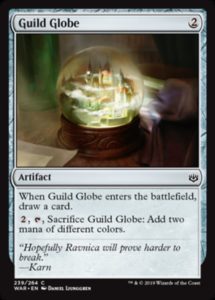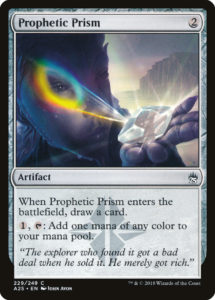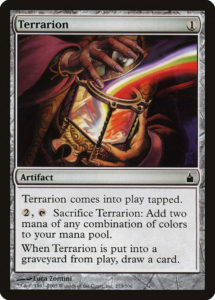We’re in unusually exciting times—War of the Spark hasn’t even been out for a month, Modern Horizons spoiler season is fully underway, and we’ve got Core 2020 spoilers following hot on its trails. Next week, we’ll be able to dive into the MH1 Limited game, but today let’s kick back and focus on the design of a single, unassuming card.
There’s a ton of design intent behind every card, even simple roleplayers for Limited. So, without further ado, let’s talk about Guild Globe.
Guild Globe looks like many cards that have come before, but is a unique design. It has elements of Prophetic Prism (my favorite card of all time), Terrarion, and Elsewhere Flask, all combined to form a unique cocktail. All of these cards are simple cantripping artifacts (some of which often appear in Modern Eggs decks, since you can crack them for mana and cards) which fix your mana (to varying degrees of effect). All of them allow you to splash off-color cards, some more effectively or consistently than others.
All four of these cards also have format-specific lenticular design that make them more the sum of their parts: Prophetic Prism enabled Improvise on Kaladesh, Terrarion enabled Delirium in Shadows Over Innistrad, Elsewhere Flash powered up the Corrupt uncommon cycle on Shadowmoor, and Guild Globe triggers all the “noncreature-spells matter” cards in War of the Spark. These styles of cards don’t often have this additional usage, but when they do, they become subtly stronger.
Having said what these cards have in common, we can now do side-by-side comparisons to appreciate their differences.
Easy and Interesting Choices
Prophetic Prism is an amazing Magic card. For the low cost of two mana, a spell slot in your deck, and zero cards (because it replaces itself), you are almost guaranteed to have zero color problems for the rest of the game—even if you’re playing a greedy manabase. Every format has powerful cards worth splashing, so the mere existence of Prophetic Prism makes multicolor goodstuff decks viable. That’s a ton of power and utility for two mana of any color.
Guild Globe is much, much weaker. It only fixes your mana once. Sure, it filters it more flexibly; but after one use, you’re done. So, case closed, Prophetic Prism is the better card—right?
Having played both cards a lot, I think Guild Globe is the more interesting design. Guild Globe provides comparable flexibility when splashing, but there is an interesting choice about when to crack it. If you’re missing one of your primary colors, do you break the globe now (but potentially be unable to cast your splash spell later on) or save the globe and hope to draw an appropriate land? Prophetic Prism, on the other hand, makes things easy. There’s no cost to using the Prism every turn (unless you’re trying to hold up multiple off-color things at once), so there’s tension when using it (or putting it into your deck). Prism allows you to be much greedier when building your manabase while requiring few decisions (a five color deck with three Prisms has three sources of every color, flexibility that Guild Globe cannot provide). For all these reasons, I think that Guild Globe is a much more interesting and fair inclusion in Limited formats. I absolutely love having access to Prophetic Prism, but it should be the exception where cards like Guild Globe should probably be the rule.
Delayed Gratification
Terrarion hails from original Ravnica, so it’s nice to see another Ravnica riff on it in War of the Spark. Terrarion is cheaper than Guild Globe and offers more flexible color production, but there’s one key difference between it and Guild Globe: when you draw the card.
Chromatic Sphere, Chromatic Star, Manamorphose, Skycloud Egg, and all the other Terrarion-like cards withhold their replacement card until you crack them. This is a major downside compared to Guild Globe, which gives you the card right away. These cards all look like they’re free mana fixers, but because they hold onto their replacement cards until you crack them, you’re often forced to break them early for no value just to get that card back. That means you’re investing three mana into a Terrarion with no guarantee that you’ll even be able to use it for fixing. Guild Globe giving you the card right away means you can save cracking it until you need the mana fixing, and never before.
In the last section, I declared Guild Globe a stronger design than Prophetic Prism because it offers a more interesting choice than Prophetic Prism‘s no-brainer. Terrarion and its ilk offer a harder choice than Guild Globe, but this choice is both less fun and less interesting.
The answer to “do I need an extra card right now?” is almost always yes, so there’s always a strong incentive to crack your eggs. While this choice is in tension with the need to save the artifact for fixing, it’s generally worse to have a card locked away behind an otherwise useless artifact when you don’t need fixing immediately, so it’s usually correct to crack it. This in turn makes them unreliable fixers, so an experienced deckbuilder generally discounts them as a full color source while less experienced players either deny themselves cards or end up color-screwing themselves. Terrarion has a high fail-rate for fixing colors, a higher cost to put into your deck, and doesn’t offer that strong of a choice. For all these reasons, I think Guild Globe is also a better designed card.
Plane-specific Design
There are only three cards in Magic with the text, “Add two mana of different colors,” and all of them are in War of the Spark. This weird line of mildly restrictive text is on Interplanar Beacon, Firemind Vessel, and of course Guild Globe. In isolation, this would be a bizarre restriction, but on Ravnica, it makes perfect sense: it’s Guild World! All color pairs are equal and (almost) all color identities are intrinsically tied to the dual color guilds.
Plane-specific designs like this as brilliant! Not only can they only be done on these worlds, but they reinforce what the plane is about in player’s minds and don’t require plane-agnostic design space. This little twist doesn’t much change the power level or effect of this card, so the cost is more than offset by the effect.
Still, I do have one small nitpick about this bit of design: it makes New Horizons look really weird. Not only does New Horizons buck the trend of three other mana fixers, but one card working subtly but appreciably differently from three others adds a tiny bit of mental taxation to a set already overburdened by complexity (thanks to the preponderance of Planeswalker static abilities).
And that’s all I have to say about Guild Globe. Hopefully you’ve enjoyed this deep dive into a workhorse card and are as excited as I am to get to play with Modern Horizons next weekend. And, as always, thanks for reading!
—Zachary Barash is a New York City-based game designer and the commissioner of Team Draft League. He designs for Kingdom Death: Monster, has a Game Design MFA from the NYU Game Center, and does freelance game design. When the stars align, he streams Magic.
His favorite card of the month is Deadly Recluse. In some formats, it’s a Doom Blade. In others, it’s a weak-hitting two drop. It’s a super context-sensitive card that punishes aggression and is punished by both control decks. It does a whole lot for a Squire with two keywords.




